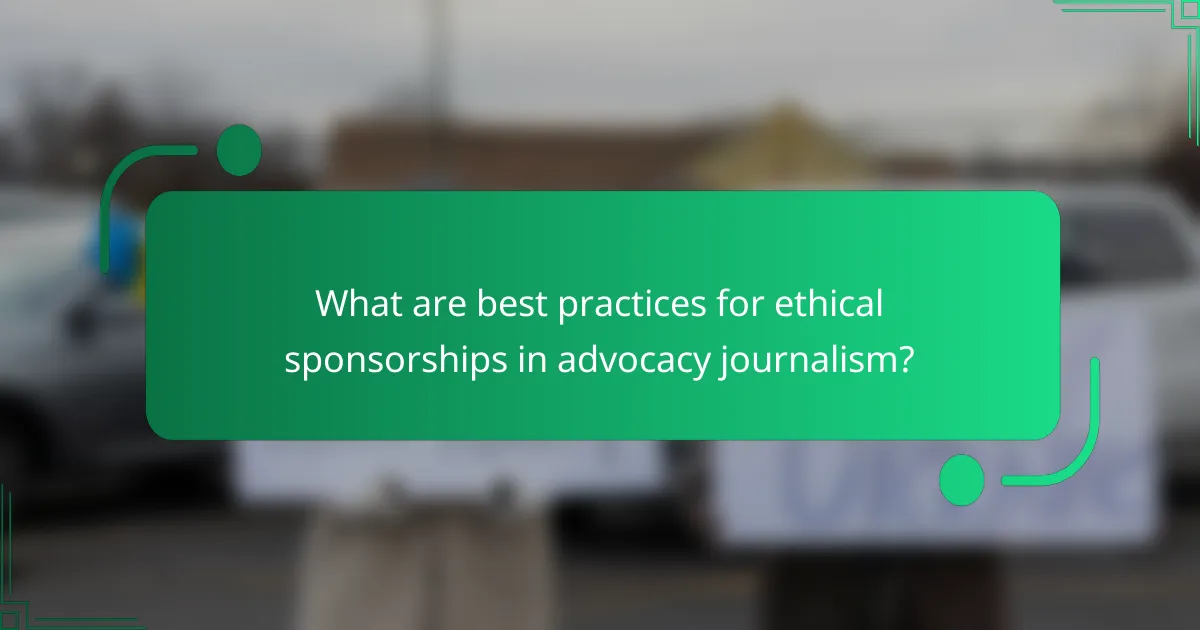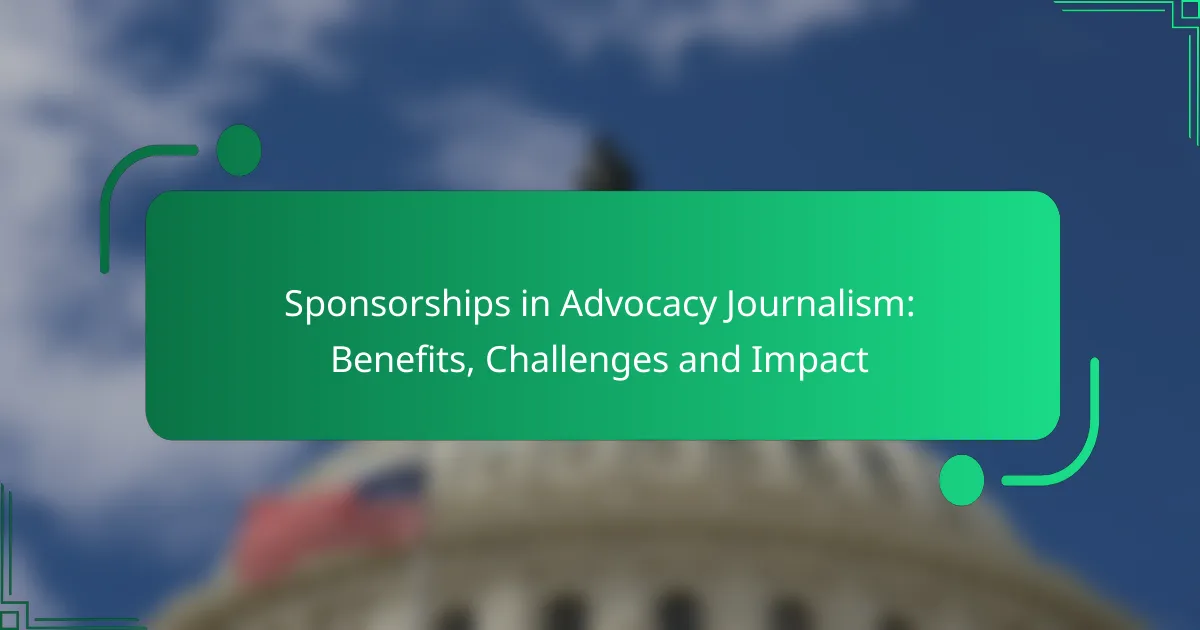Sponsorships in advocacy journalism present a dual-edged sword, offering vital funding and enhanced credibility while also posing challenges such as potential conflicts of interest. These financial partnerships can empower journalists to address pressing issues and amplify marginalized voices, yet they may also compromise journalistic integrity and independence. As audience perceptions are shaped by the awareness of sponsorships, the impact on trust and engagement becomes a critical consideration for both journalists and their supporters.

What are the benefits of sponsorships in advocacy journalism?
Sponsorships in advocacy journalism offer significant advantages, including increased funding, enhanced credibility, and broader audience engagement. These benefits can empower journalists to tackle critical issues and amplify underrepresented voices.
Increased funding for investigative projects
Sponsorships provide essential financial support for investigative journalism, allowing projects that may otherwise lack resources to come to fruition. This funding can cover costs such as research, travel, and personnel, enabling deeper dives into complex topics.
For example, a sponsorship from a nonprofit organization focused on environmental issues might fund a series of articles investigating local pollution sources. This financial backing can lead to impactful stories that drive public awareness and policy change.
Enhanced credibility through association
Partnering with reputable sponsors can enhance the credibility of advocacy journalism. When established organizations support a project, it signals to the audience that the work is trustworthy and significant.
For instance, a collaboration with a well-known human rights organization can lend authority to a journalist’s coverage of social justice issues, making the findings more compelling to readers and stakeholders.
Broader audience reach and engagement
Sponsorships can help advocacy journalism reach wider audiences through the sponsor’s established networks. This expanded reach can lead to increased engagement and awareness of critical issues.
For example, a media outlet partnering with a large educational institution can share content across the institution’s platforms, attracting students and faculty who may not have otherwise engaged with the journalism.
Access to expert resources and networks
Sponsors often provide access to valuable resources, including expert insights and professional networks. This can enhance the quality of journalism by incorporating diverse perspectives and specialized knowledge.
For instance, a sponsorship from a healthcare organization might connect journalists with medical professionals who can provide expert commentary on health-related stories, enriching the content’s depth and accuracy.
Support for underrepresented issues
Sponsorships can shine a light on underrepresented issues that may not receive adequate coverage otherwise. By aligning with sponsors focused on specific causes, journalists can bring attention to important topics that resonate with marginalized communities.
For example, a sponsorship from a nonprofit advocating for mental health awareness can enable journalists to produce in-depth articles that highlight the challenges faced by individuals in this area, fostering greater understanding and empathy.

What challenges do sponsorships pose in advocacy journalism?
Sponsorships in advocacy journalism can create significant challenges, including potential conflicts of interest and pressures to conform to sponsor agendas. These issues can undermine the integrity and independence of journalistic practices, making it essential for journalists to navigate these relationships carefully.
Potential conflicts of interest
Conflicts of interest arise when sponsorships influence the content or direction of advocacy journalism. For instance, if a nonprofit organization sponsors a media outlet, there may be an implicit expectation that the coverage will favor the sponsor’s agenda. This can lead to biased reporting, which can misinform the audience.
Journalists must disclose any financial relationships with sponsors to maintain transparency. Failure to do so can damage credibility and trust with the audience, which is crucial in advocacy journalism.
Pressure to align with sponsor agendas
Sponsors often have specific goals or messages they want to promote, which can pressure journalists to align their reporting accordingly. This pressure can manifest in subtle ways, such as avoiding critical coverage of the sponsor’s initiatives or emphasizing positive aspects disproportionately.
To counteract this pressure, journalists should establish clear editorial guidelines that prioritize independent reporting. Regular discussions about the boundaries of sponsorship influence can help maintain focus on journalistic integrity.
Risk of compromising journalistic integrity
When sponsorships dictate content, there is a significant risk of compromising journalistic integrity. This can lead to a loss of objectivity, where stories are crafted to serve the interests of sponsors rather than the public interest.
Maintaining a commitment to ethical journalism is vital. Journalists should adhere to established codes of ethics, such as those from the Society of Professional Journalists, which emphasize accuracy, fairness, and accountability.
Difficulty in maintaining editorial independence
Maintaining editorial independence can be challenging in a sponsorship model. Journalists may find it difficult to report on issues that could negatively impact their sponsors, leading to self-censorship and a lack of critical discourse.
To preserve independence, media organizations should create a firewall between editorial and sponsorship teams. This separation can help ensure that editorial decisions are made based on journalistic principles rather than financial considerations.

How do sponsorships impact audience perception in the US?
Sponsorships can significantly influence audience perception in the US by shaping how content is viewed in terms of trustworthiness and bias. When audiences are aware of sponsorships, their interpretation of the information presented may shift, affecting their overall engagement and belief in the content’s integrity.
Influence on trust and credibility
Sponsorships can enhance or undermine trust and credibility depending on the audience’s awareness and perception of the sponsor. If the sponsor is well-respected, it may lend credibility to the journalism; however, if the sponsor is controversial, it can lead to skepticism about the content’s objectivity. Transparency about sponsorships is crucial to maintaining audience trust.
For instance, a news outlet funded by a reputable nonprofit may be viewed as more credible than one backed by a corporate entity with a vested interest in the topic. Clear disclosure of sponsorships helps audiences assess the reliability of the information presented.
Changes in audience engagement levels
The presence of sponsorships can alter audience engagement levels, either positively or negatively. When audiences perceive sponsorship as a sign of quality or support for important issues, they may engage more deeply with the content. Conversely, if they view sponsorship as a commercial influence, engagement may decline.
Engagement can be measured through metrics such as time spent on articles, social media shares, and comments. For example, content that is sponsored by a trusted organization may see higher interaction rates compared to similar content without sponsorship.
Perception of bias in reporting
Sponsorships often lead to concerns about bias in reporting, as audiences may question the independence of the journalism. If a publication is sponsored by a company related to the subject matter, readers might suspect that the reporting is skewed to favor the sponsor’s interests.
To mitigate perceptions of bias, journalists should strive for balanced reporting and disclose sponsorships clearly. Providing a range of perspectives on issues can help reinforce the integrity of the content and alleviate concerns about undue influence from sponsors.

What are best practices for ethical sponsorships in advocacy journalism?
Best practices for ethical sponsorships in advocacy journalism focus on transparency, independence, and clear guidelines. These practices ensure that the integrity of the journalism is maintained while allowing for necessary funding from sponsors.
Clear disclosure of sponsorship relationships
Clear disclosure of sponsorship relationships is essential for maintaining trust with the audience. Journalists should openly communicate who their sponsors are and the nature of the sponsorship, ideally in every piece of content that is influenced by the sponsorship.
For example, a simple statement at the beginning or end of an article can clarify the sponsor’s involvement. This transparency helps readers understand potential biases and the financial interests behind the content.
Maintaining editorial control and independence
Maintaining editorial control and independence is crucial to uphold journalistic integrity. Advocacy journalists should ensure that sponsors do not have any influence over the content, tone, or direction of the reporting.
Establishing a clear separation between editorial decisions and sponsorship interests can be achieved through internal policies. For instance, having a dedicated editorial board that reviews content before publication can help safeguard independence.
Establishing guidelines for sponsor involvement
Establishing guidelines for sponsor involvement helps define the boundaries of sponsorship in advocacy journalism. These guidelines should outline what sponsors can and cannot do, including restrictions on content approval and the types of topics covered.
Creating a written policy that is shared with sponsors can prevent misunderstandings. For example, a guideline might state that sponsors cannot dictate the narrative or influence the selection of stories, ensuring that the journalism remains unbiased and factual.

How can advocacy journalists select appropriate sponsors?
Advocacy journalists can select appropriate sponsors by ensuring alignment between the sponsor’s values and their own journalistic mission. This involves evaluating potential sponsors based on their reputation, ethical standards, and commitment to the causes that the journalist supports.
Assessing Alignment with Values
When choosing sponsors, advocacy journalists should prioritize those whose missions resonate with their own. This alignment not only enhances credibility but also fosters trust among the audience. For instance, a journalist focused on environmental issues might seek sponsorship from organizations dedicated to sustainability.
Evaluating Sponsor Reputation
It’s crucial to research the reputation of potential sponsors. Journalists should consider public perception, past controversies, and the sponsor’s history of supporting similar causes. Engaging with community feedback can provide insights into how a sponsor is viewed, helping to avoid partnerships that could harm the journalist’s credibility.
Understanding Financial Implications
Advocacy journalists must be aware of the financial implications of sponsorships. This includes understanding the terms of funding, potential restrictions on content, and the overall impact on journalistic independence. Clear agreements that outline expectations can help mitigate conflicts of interest.
Maintaining Transparency
Transparency is essential in sponsorships. Journalists should disclose sponsorship relationships to their audience to maintain trust and integrity. Clear communication about how sponsorships influence content can help audiences understand the context and motivations behind the journalism.
Monitoring and Evaluating Partnerships
After establishing sponsorships, advocacy journalists should continuously monitor and evaluate these partnerships. Regular assessments can help identify any shifts in alignment or reputation that may affect the journalist’s work. This proactive approach ensures that sponsorships remain beneficial and ethically sound over time.
